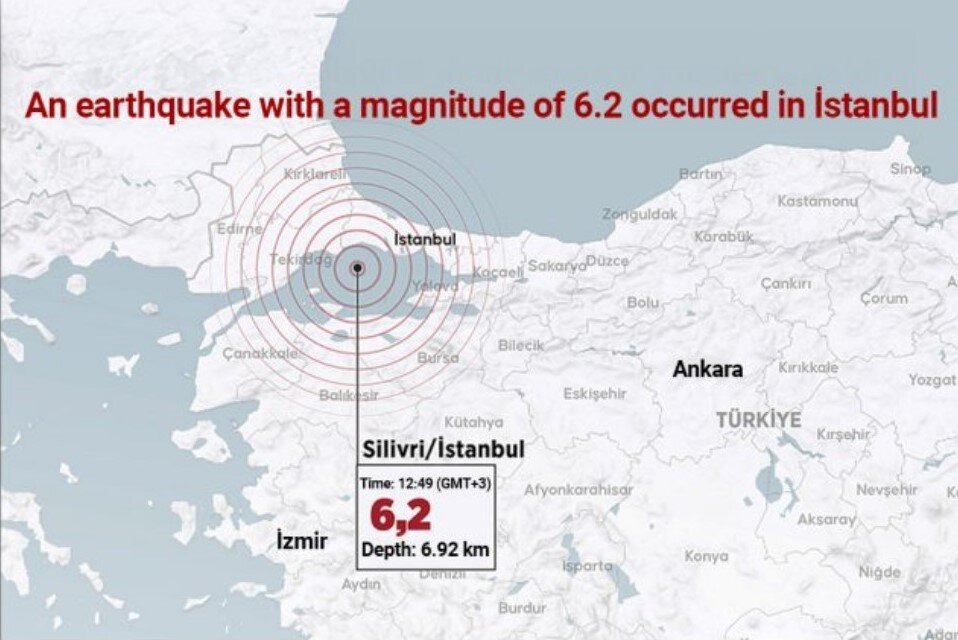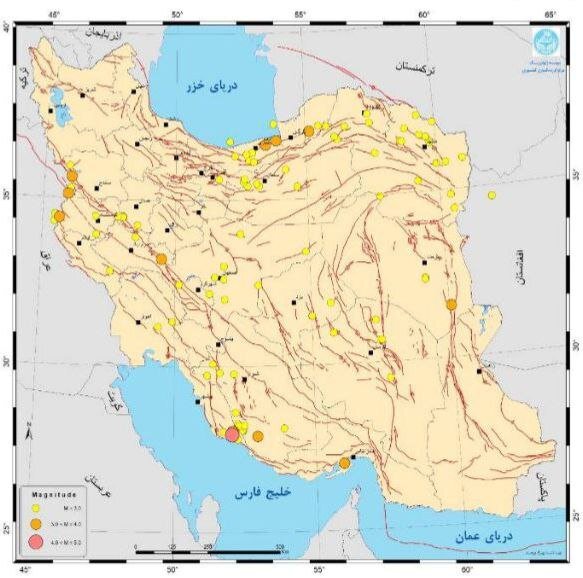6.2 Magnitude Earthquake Rocks Sea of Marmara: Major Istanbul Earthquake Warning Issued!
On April 23, 2025, a strong earthquake measuring 6.2 on the Richter scale shook the Sea of Marmara, located just 40 km from Istanbul, Turkiye. The earthquake struck at 12:49 PM local time, and all thirty-three stations of the IIEES Iranian broadband seismic network recorded its effects. This seismic event has raised concerns about Istanbul’s vulnerability to future earthquakes, particularly due to the region’s history of significant seismic activity.
The earthquake’s epicenter was approximately 10 km deep and situated about 40 km southwest of Istanbul within the Sea of Marmara. The mechanism of this earthquake is classified as a strike-slip, which is typical for this region.
The Istanbul area is known for its seismic activity, primarily due to its proximity to the North Anatolian Fault (NAF). This fault system has been responsible for several devastating earthquakes throughout history. The following points highlight the key facts about the seismic risk in this region:
- Seismic History: Istanbul has experienced at least 34 major earthquakes in the last 2,000 years.
- Major Past Events: The 1509 earthquake, known as the “Little Apocalypse,” had an estimated magnitude of 7.4 and caused extensive destruction in Constantinople, resulting in thousands of deaths.
- Recent Earthquakes: The last major earthquake in the area occurred in 1999 in Izmit, about 80 km southeast of Istanbul, highlighting the vulnerability of many buildings.
- Current Vulnerability: Only about one-third of Istanbul’s buildings are deemed structurally resilient to seismic activity, raising concerns about future quakes.
As stress accumulates along the North Anatolian Fault, experts estimate a 65% to 70% chance of an earthquake with a magnitude of 7 or higher occurring by 2040. The potential implications of such a seismic event are dire:
- Up to 600,000 homes could be destroyed.
- Millions of people may be affected, leading to widespread displacement.
- Tsunami warnings have been issued since the April 23 earthquake, indicating that significant ruptures could generate waves reaching up to 10 meters high.
The North Anatolian Fault is a right-lateral strike-slip fault where the Anatolian Plate is moving westward relative to the Eurasian Plate at a rate of 2 to 3 cm per year. A complete rupture of the Marmara section, which spans approximately 150-200 km, could result in an earthquake ranging from M7.0 to M7.8.
The population density in Istanbul is around 16 million, and a large portion of the city’s structures are dilapidated or vulnerable to seismic impacts. To further complicate the situation, soft sediments along the Marmara coast can amplify tremors, and the risk of liquefaction in coastal areas heightens the hazards associated with an earthquake. The following points summarize the potential risks:
- Infrastructure Vulnerability: Key facilities such as hospitals and bridges may fail during a major earthquake.
- Emergency Response Challenges: Istanbul’s dense urban layout would complicate emergency response efforts.
- Historical Context: The last major rupture in the Marmara Sea section occurred in 1766, making it a critical segment for future seismic activity.
The significance of the April 23, 2025 earthquake cannot be overstated. It has prompted a reassessment of the likelihood of another seismic event in the region. Experts suggest that the recent quake could have a domino effect on the locked fault segment near Istanbul, which has not ruptured for over 250 years. With an estimated probability of 62-75%, a significant earthquake could occur in the vicinity of Istanbul by 2040.
Despite the introduction of stricter construction regulations following the 1999 Izmit earthquake, issues of poor construction and illegal building practices persist. Approximately 40% of Istanbul’s buildings are at risk of collapse, exacerbating the city’s vulnerability. Furthermore, since 1999, only 10% of vulnerable buildings have undergone retrofitting.
In conclusion, Istanbul stands at a critical juncture concerning its seismic risk. The accumulation of tectonic stress along the North Anatolian Fault, combined with the city’s population density and infrastructure vulnerabilities, paints a concerning picture for the future. A significant earthquake in this region could not only be one of the natural disasters of the 21st century but it could also lead to catastrophic loss of life and severe economic consequences for Turkiye and the surrounding areas.






